Tsuchime-like Aluminum Film to Enhance Absorption in Ultra-Thin Photovoltaic Cells
Abstract
:1. Introduction
2. Materials and Methods
3. Results and Discussion
3.1. Diameter of Nanocraters (dNC)
3.2. Thickness of the Active Silicon Layer (HSi)
3.3. Effect of the Active Layer Material
4. Conclusions
Author Contributions
Funding
Data Availability Statement
Acknowledgments
Conflicts of Interest
References
- Jiang, Y.; Khan, H. The relationship between renewable energy consumption, technological innovations, and carbon dioxide emission: Evidence from two-step system GMM. Environ. Sci. Pollut. Res. 2023, 30, 4187–4202. [Google Scholar] [CrossRef]
- Oyewole, K.A.; Okedere, O.B.; Rabiu, K.O.; Alawode, K.O.; Oyelami, S. Carbon dioxide emission, mitigation and storage technologies pathways. Sustain. Environ. 2023, 9, 2188760. [Google Scholar] [CrossRef]
- Alsarhan, L.M.; Alayyar, A.S.; Alqahtani, N.B.; Khdary, N.H. Circular Carbon Economy (CCE): A Way to Invest CO2 and Protect the Environment, a Review. Sustainability 2021, 13, 11625. [Google Scholar] [CrossRef]
- Mallapaty, S. How China could be carbon neutral by mid-century. Nature 2020, 586, 482–483. [Google Scholar] [CrossRef] [PubMed]
- Kim, S.; van Hoang, Q.; Bark, C.W. Silicon-Based Technologies for Flexible Photovoltaic (PV) Devices: From Basic Mechanism to Manufacturing Technologies. Nanomaterials 2021, 11, 2944. [Google Scholar] [CrossRef]
- Worsley, E.A.; Margadonna, S.; Bertoncello, P. Application of Graphene Nanoplatelets in Supercapacitor Devices: A Review of Recent Developments. Nanomaterials 2022, 12, 3600. [Google Scholar] [CrossRef]
- Anwar, A.R.; Sajjad, M.T.; Johar, M.A.; Hernández-Gutiérrez, C.A.; Usman, M.; Łepkowski, S.P. Recent Progress in Micro-LED-Based Display Technologies. Laser Photonics Rev. 2022, 16, 2100427. [Google Scholar] [CrossRef]
- Statista. U.S. Smartphones Replacement Cycle 2013–2027|Statista. Available online: https://www.statista.com/statistics/619788/average-smartphone-life/ (accessed on 4 May 2023).
- Miao, W.-C.; Hong, Y.-H.; Hsiao, F.-H.; Chen, J.-D.; Chiang, H.; Lin, C.-L.; Lin, C.-C.; Chen, S.-C.; Kuo, H.-C. Modified Distributed Bragg Reflectors for Color Stability in InGaN Red Micro-LEDs. Nanomaterials 2023, 13, 661. [Google Scholar] [CrossRef]
- Obaideen, K.; Olabi, A.G.; Al Swailmeen, Y.; Shehata, N.; Abdelkareem, M.A.; Alami, A.H.; Rodriguez, C.; Sayed, E.T. Solar Energy: Applications, Trends Analysis, Bibliometric Analysis and Research Contribution to Sustainable Development Goals (SDGs). Sustainability 2023, 15, 1418. [Google Scholar] [CrossRef]
- Saravanapavanantham, M.; Mwaura, J.; Bulović, V. Printed Organic Photovoltaic Modules on Transferable Ultra-thin Substrates as Additive Power Sources. Small Methods 2023, 7, e2200940. [Google Scholar] [CrossRef]
- Massiot, I.; Cattoni, A.; Collin, S. Progress and prospects for ultrathin solar cells. Nat. Energy 2020, 5, 959–972. [Google Scholar] [CrossRef]
- Hamouche, H.; Shabat, M.M. Optical absorption in roughened silicon photovoltaic module. Optik 2023, 274, 170566. [Google Scholar] [CrossRef]
- Zhu, J.; Hsu, C.-M.; Yu, Z.; Fan, S.; Cui, Y. Nanodome solar cells with efficient light management and self-cleaning. Nano Lett. 2010, 10, 1979–1984. [Google Scholar] [CrossRef] [PubMed]
- Battaglia, C.; Hsu, C.-M.; Söderström, K.; Escarré, J.; Haug, F.-J.; Charrière, M.; Boccard, M.; Despeisse, M.; Alexander, D.T.L.; Cantoni, M.; et al. Light trapping in solar cells: Can periodic beat random? ACS Nano 2012, 6, 2790–2797. [Google Scholar] [CrossRef]
- Obraztsova, A.A.; Barettin, D.; Furasova, A.D.; Voroshilov, P.M.; auf der Maur, M.; Orsini, A.; Makarov, S.V. Light-Trapping Electrode for the Efficiency Enhancement of Bifacial Perovskite Solar Cells. Nanomaterials 2022, 12, 3210. [Google Scholar] [CrossRef] [PubMed]
- Bläsi, B.; Hanser, M.; Jäger, K.; Höhn, O. Light trapping gratings for solar cells: An analytical period optimization approach. Opt. Express 2022, 30, 24762–24772. [Google Scholar] [CrossRef] [PubMed]
- Dragoman, D. Nanomaterials for Energy Harvesting. Nanomaterials 2023, 13, 1154. [Google Scholar] [CrossRef]
- Peter Amalathas, A.; Alkaisi, M.M. Nanostructures for Light Trapping in Thin Film Solar Cells. Micromachines 2019, 10, 619. [Google Scholar] [CrossRef]
- Li, X.; Zhang, C.; Yang, Z.; Shang, A. Broadband, polarization-insensitive and wide-angle absorption enhancement of a-Si:H/μc-Si:H tandem solar cells by nanopatterning a-Si:H layer. Opt. Express 2013, 21 (Suppl. S4), A677–A686. [Google Scholar] [CrossRef]
- Schaadt, D.M.; Feng, B.; Yu, E.T. Enhanced semiconductor optical absorption via surface plasmon excitation in metal nanoparticles. Appl. Phys. Lett. 2005, 86, 063106. [Google Scholar] [CrossRef]
- Jacak, W.A. Quantum Nano-Plasmonics; Cambridge University Press: Cambridge, UK, 2020; ISBN 9781108777698. [Google Scholar]
- Hubarevich, A.; Marus, M.; Stsiapanau, A.; Smirnov, A.; Zhao, J.; Fan, W.; Wang, H.; Sun, X. Transparent conductive nanoporous aluminium mesh prepared by electrochemical anodizing. Phys. Status Solidi A 2015, 212, 2174–2178. [Google Scholar] [CrossRef]
- Marus, M.; Hubarevich, A.; Wang, H.; Stsiapanau, A.; Smirnov, A.; Sun, X.W.; Fan, W. Comparative analysis of opto-electronic performance of aluminium and silver nano-porous and nano-wired layers. Opt. Express 2015, 23, 26794–26799. [Google Scholar] [CrossRef]
- Hubarevich, A.; Marus, M.; Fan, W.; Smirnov, A.; Sun, X.W.; Wang, H. Theoretical comparison of optical and electronic properties of uniformly and randomly arranged nano-porous ultra-thin layers. Opt. Express 2015, 23, 17860–17865. [Google Scholar] [CrossRef]
- Roy, R.; Mondal, I.; Singh, A.K. Fabrication of an anodized nanoporous aluminium (AAO/Al) transparent electrode as an ITO alternative for PDLC smart windows. Mater. Adv. 2023, 4, 923–931. [Google Scholar] [CrossRef]
- Masuda, H.; Fukuda, K. Ordered metal nanohole arrays made by a two-step replication of honeycomb structures of anodic alumina. Science 1995, 268, 1466–1468. [Google Scholar] [CrossRef] [PubMed]
- Sousa, C.T.; Leitao, D.C.; Proenca, M.P.; Ventura, J.; Pereira, A.M.; Araujo, J.P. Nanoporous alumina as templates for multifunctional applications. Appl. Phys. Rev. 2014, 1, 31102. [Google Scholar] [CrossRef]
- Lu, S.; Sun, Y.; Ren, K.; Liu, K.; Wang, Z.; Qu, S. Recent Development in ITO-free Flexible Polymer Solar Cells. Polymers 2017, 10, 5. [Google Scholar] [CrossRef]
- Li, Y.; Chen, Y.; Qiu, M.; Yu, H.; Zhang, X.; Sun, X.W.; Chen, R. Preparation of Aluminum Nanomesh Thin Films from an Anodic Aluminum Oxide Template as Transparent Conductive Electrodes. Sci. Rep. 2016, 6, 20114. [Google Scholar] [CrossRef]
- Hubarevich, A.; Marus, M.; Fan, W.; Smirnov, A.; Wang, H. Highly Efficient Ultrathin Plasmonic Insulator-Metal-Insulator-Metal Solar Cell. Plasmonics 2018, 13, 141–145. [Google Scholar] [CrossRef]
- Young, W.A. Notes on a Bygone Japanese Craft with Special Reference to Materials and Technique. Trans. Newcom. Soc. 1936, 17, 91–107. [Google Scholar] [CrossRef]
- COMSOL. COMSOL: Multiphysics Software for Optimizing Designs. Available online: https://www.comsol.com/ (accessed on 4 May 2023).
- Green, M.A. Self-consistent optical parameters of intrinsic silicon at 300K including temperature coefficients. Sol. Energy Mater. Sol. Cells 2008, 92, 1305–1310. [Google Scholar] [CrossRef]
- Rakic, A.D.; Djurisic, A.B.; Elazar, J.M.; Majewski, M.L. Optical properties of metallic films for vertical-cavity optoelectronic devices. Appl. Opt. 1998, 37, 5271–5283. [Google Scholar] [CrossRef] [PubMed]
- Kluczyk, K.; David, C.; Jacak, J.; Jacak, W. On Modeling of Plasmon-Induced Enhancement of the Efficiency of Solar Cells Modified by Metallic Nano-Particles. Nanomaterials 2018, 9, 3. [Google Scholar] [CrossRef] [PubMed]
- Campa, A.; Krc, J.; Topic, M. Two approaches for incoherent propagation of light in rigorous numerical simulations. PIER 2013, 137, 187–202. [Google Scholar] [CrossRef]
- Mitra, S.K. Digital Signal Processing: A Computer Based Approach, 2nd ed.; McGraw-Hill Higher Educagion: New York, NY, USA, 2001; ISBN 0072522615. [Google Scholar]
- Oppenheim, A.V.; Schafer, R.W. Discrete-Time Signal Processing, 3rd ed.; Pearson: Upper Saddle River, NJ, USA, 2010; ISBN 0137549202. [Google Scholar]
- Box, G.E.P.; Jenkins, G.M.; Reinsel, G.C.; Ljung, G.M. Time Series Analysis: Forecasting and Control, 5th ed.; Wiley: Hoboken, NJ, USA; EBSCO Industries: Ipswich, MA, USA, 2016; ISBN 9781118674925. [Google Scholar]
- Hyndman, R.J.; Athanasopoulos, G. Forecasting: Principles and Practice, 2nd ed.; Springer: Berlin/Heidelberg, Germany, 2016; Available online: https://otexts.com/fpp2/ (accessed on 18 May 2023).
- Zeng, Y.; Núñez, A.; Li, Z. Speckle noise reduction for structural vibration measurement with laser Doppler vibrometer on moving platform. Mech. Syst. Signal Process. 2022, 178, 109196. [Google Scholar] [CrossRef]
- Chen, X.; Yu, D.; Cao, L.; Zhu, X.; Song, Y.; Huang, H.; Lu, L.; Chen, X. Fabrication of ordered porous anodic alumina with ultra-large interpore distances using ultrahigh voltages. Mater. Res. Bull. 2014, 57, 116–120. [Google Scholar] [CrossRef]
- Zhang, D.; Zhang, H.; Guo, H.; Ye, F.; Liu, S.; Wu, Y. Stable α-FAPbI 3 in Inverted Perovskite Solar Cells with Efficiency Exceeding 22% via a Self-Passivation Strategy. Adv. Funct. Mater. 2022, 32, 2200174. [Google Scholar] [CrossRef]
- Noman, M.; Shahzaib, M.; Jan, S.T.; Shah, S.N.; Khan, A.D. 26.48% efficient and stable FAPbI3 perovskite solar cells employing SrCu2O2 as hole transport layer. RSC Adv. 2023, 13, 1892–1905. [Google Scholar] [CrossRef]
- Jeong, J.; Kim, M.; Seo, J.; Lu, H.; Ahlawat, P.; Mishra, A.; Yang, Y.; Hope, M.A.; Eickemeyer, F.T.; Kim, M.; et al. Pseudo-halide anion engineering for α-FAPbI3 perovskite solar cells. Nature 2021, 592, 381–385. [Google Scholar] [CrossRef]
- Min, H.; Kim, M.; Lee, S.-U.; Kim, H.; Kim, G.; Choi, K.; Lee, J.H.; Seok, S.I. Efficient, stable solar cells by using inherent bandgap of α-phase formamidinium lead iodide. Science 2019, 366, 749–753. [Google Scholar] [CrossRef]
- Stanić, D.; Kojić, V.; Bohač, M.; Čižmar, T.; Juraić, K.; Rath, T.; Gajović, A. Simulation and Optimization of FAPbI3 Perovskite Solar Cells with a BaTiO3 Layer for Efficiency Enhancement. Materials 2022, 15, 7310. [Google Scholar] [CrossRef] [PubMed]
- Laska, M.; Krzemińska, Z.; Kluczyk-Korch, K.; Schaadt, D.; Popko, E.; Jacak, W.A.; Jacak, J.E. Metallization of solar cells, exciton channel of plasmon photovoltaic effect in perovskite cells. Nano Energy 2020, 75, 104751. [Google Scholar] [CrossRef]
- Zhang, W.; Saliba, M.; Stranks, S.D.; Sun, Y.; Shi, X.; Wiesner, U.; Snaith, H.J. Enhancement of perovskite-based solar cells employing core-shell metal nanoparticles. Nano Lett. 2013, 13, 4505–4510. [Google Scholar] [CrossRef] [PubMed]
- Wu, R.; Yang, B.; Zhang, C.; Huang, Y.; Cui, Y.; Liu, P.; Zhou, C.; Hao, Y.; Gao, Y.; Yang, J. Prominent Efficiency Enhancement in Perovskite Solar Cells Employing Silica-Coated Gold Nanorods. J. Phys. Chem. C 2016, 120, 6996–7004. [Google Scholar] [CrossRef]
- Chan, G.H.; Zhao, J.; Schatz, G.C.; van Duyne, R.P. Localized Surface Plasmon Resonance Spectroscopy of Triangular Aluminum Nanoparticles. J. Phys. Chem. C 2008, 112, 13958–13963. [Google Scholar] [CrossRef]
- Zhang, X.; Wang, J.; Li, Z.; Guo, S.; Tong, Y.; Liu, B.; Yue, G.; Hao, Y. Improved photovoltaic performance of PTB7:PC71BM blend by thermal annealing and solvent vapor annealing. Colloid. Polym. Sci. 2023, 301, 11–18. [Google Scholar] [CrossRef]
- Song, L.; Wang, W.; Barabino, E.; Yang, D.; Körstgens, V.; Zhang, P.; Roth, S.V.; Müller-Buschbaum, P. Composition-Morphology Correlation in PTB7-Th/PC71BM Blend Films for Organic Solar Cells. ACS Appl. Mater. Interfaces 2019, 11, 3125–3135. [Google Scholar] [CrossRef]
- Alahmadi, A.N.M. Design of an Efficient PTB7:PC70BM-Based Polymer Solar Cell for 8% Efficiency. Polymers 2022, 14, 889. [Google Scholar] [CrossRef]
- Luceño-Sánchez, J.A.; Díez-Pascual, A.M.; Peña Capilla, R. Materials for Photovoltaics: State of Art and Recent Developments. Int. J. Mol. Sci. 2019, 20, 976. [Google Scholar] [CrossRef]
- Mishra, A.K.; Shukla, R.K. Simulation of photovoltaic material (donor blends PTB7:PC70BM) polymer for solar cell application. Mater. Today Proc. 2021, 46, 2288–2293. [Google Scholar] [CrossRef]
- Li, J.; Zuo, L.; Pan, H.; Jiang, H.; Liang, T.; Shi, Y.; Chen, H.; Xu, M. Texture design of electrodes for efficiency enhancement of organic solar cells. J. Mater. Chem. A 2013, 1, 2379. [Google Scholar] [CrossRef]
- Li, X.; Hu, Y.; Deng, Z.; Xu, D.; Hou, Y.; Lou, Z.; Teng, F. Efficiency improvement of polymer solar cells with random micro-nanostructured back electrode formed by active layer self-aggregation. Org. Electron. 2017, 41, 362–368. [Google Scholar] [CrossRef]
- Kang, D.J.; Kang, H.; Cho, C.; Kim, K.-H.; Jeong, S.; Lee, J.-Y.; Kim, B.J. Efficient light trapping in inverted polymer solar cells by a randomly nanostructured electrode using monodispersed polymer nanoparticles. Nanoscale 2013, 5, 1858–1863. [Google Scholar] [CrossRef] [PubMed]
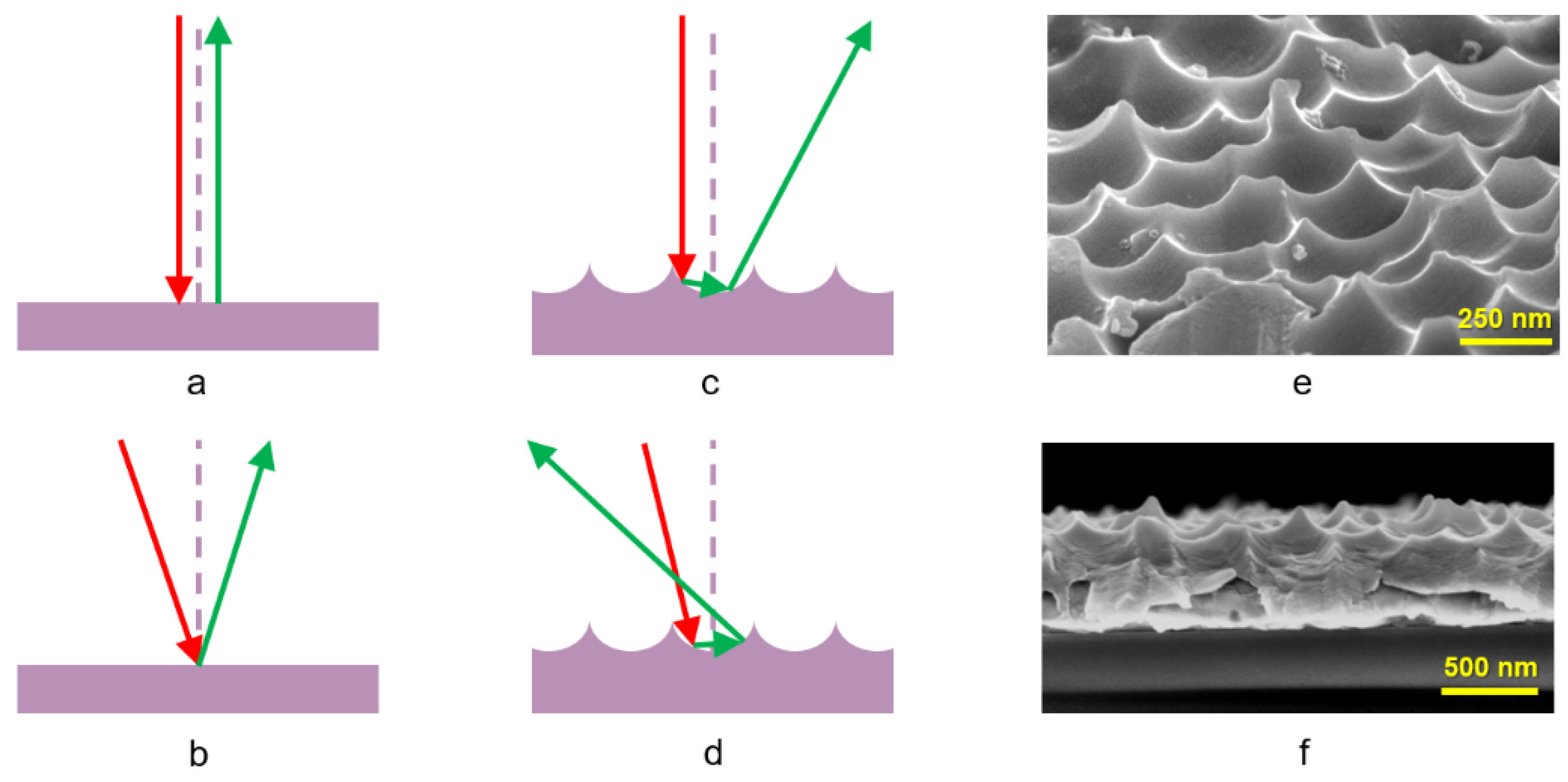
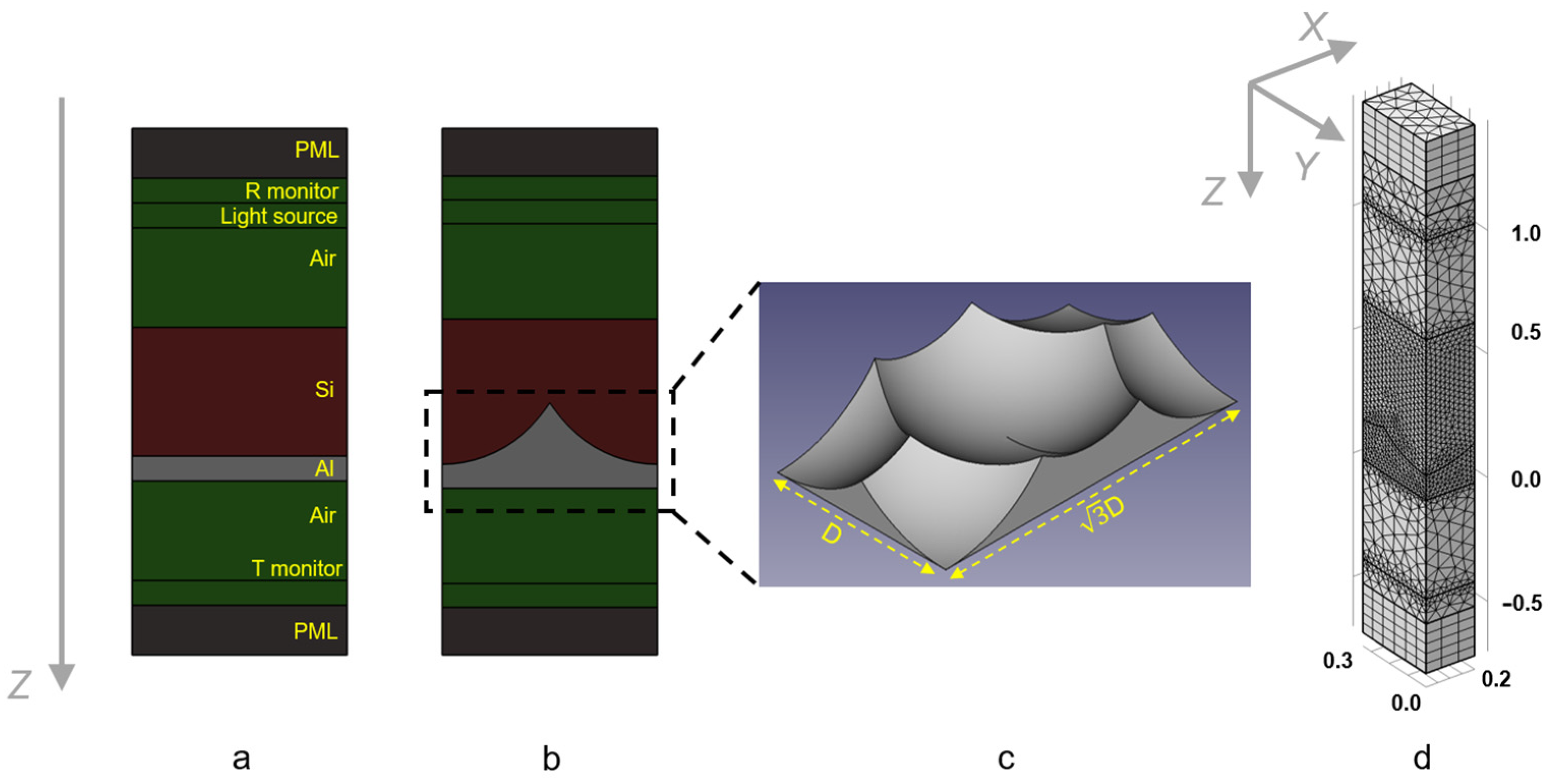
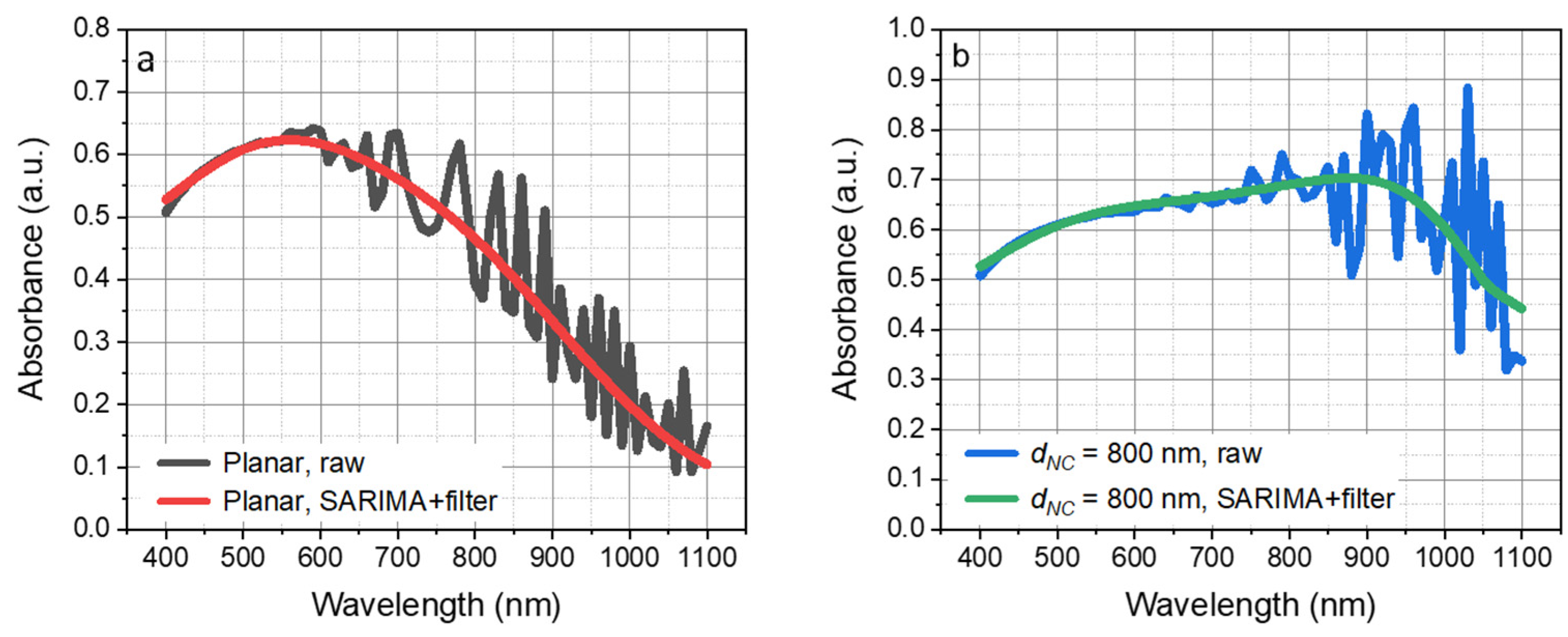
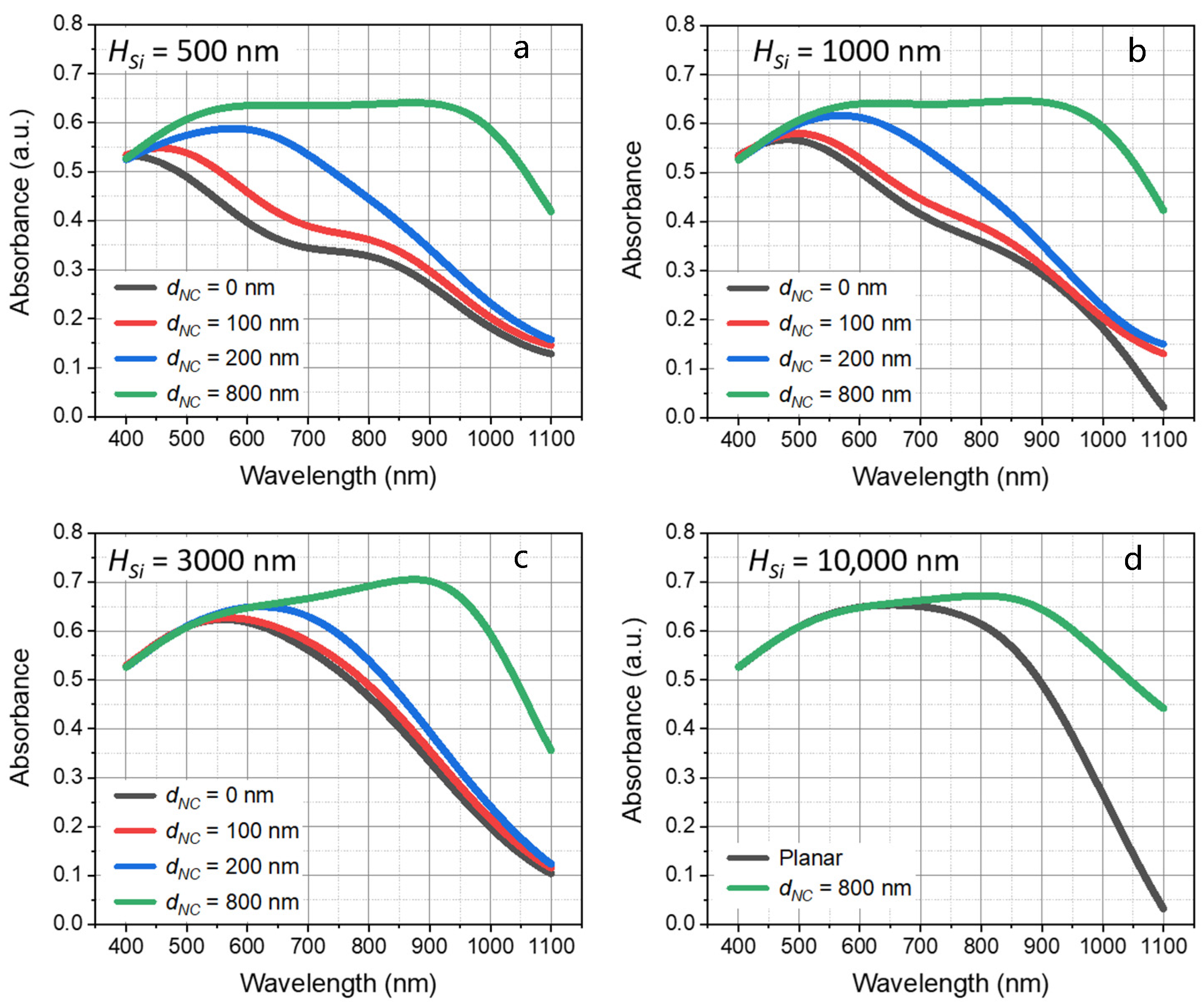
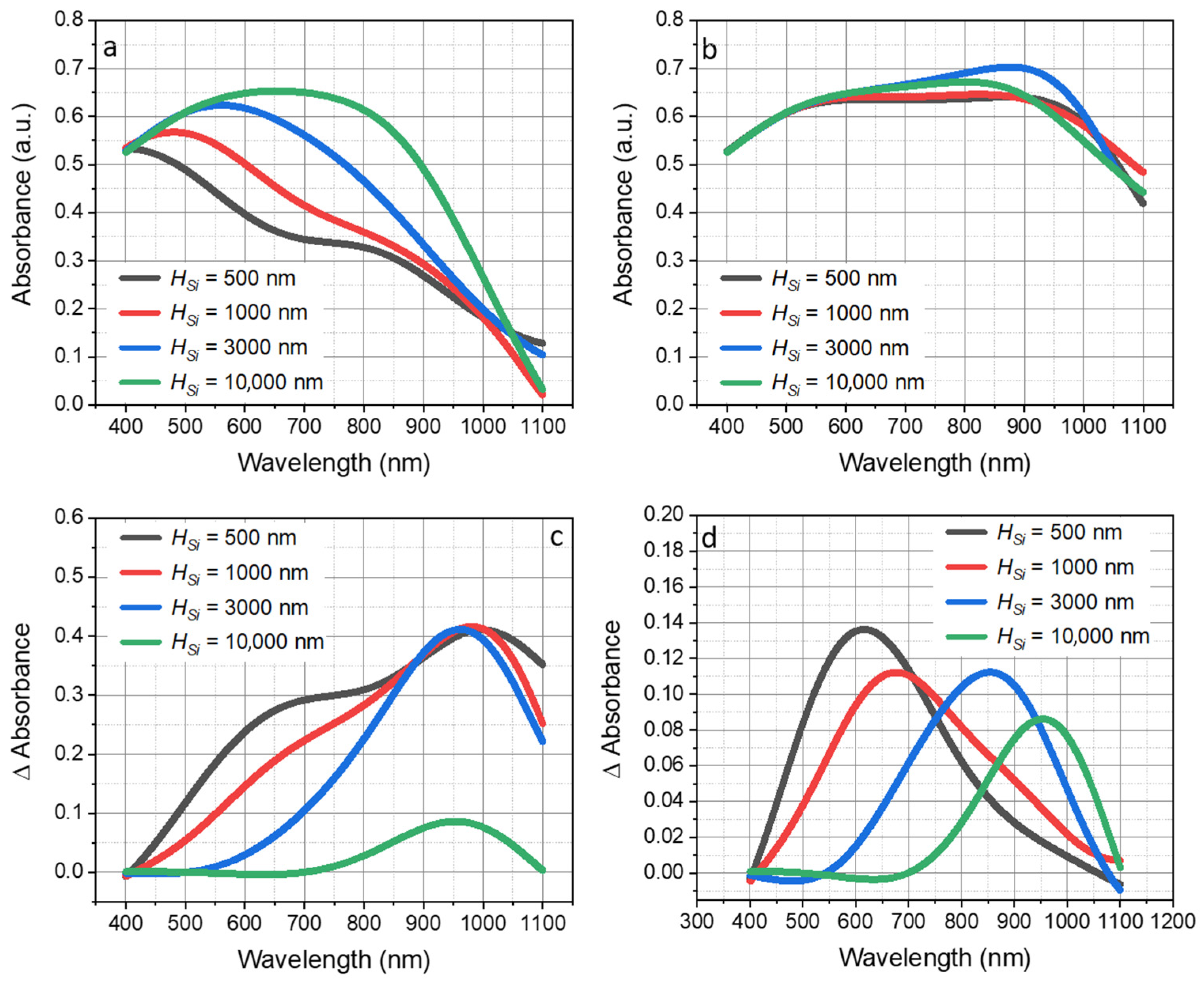
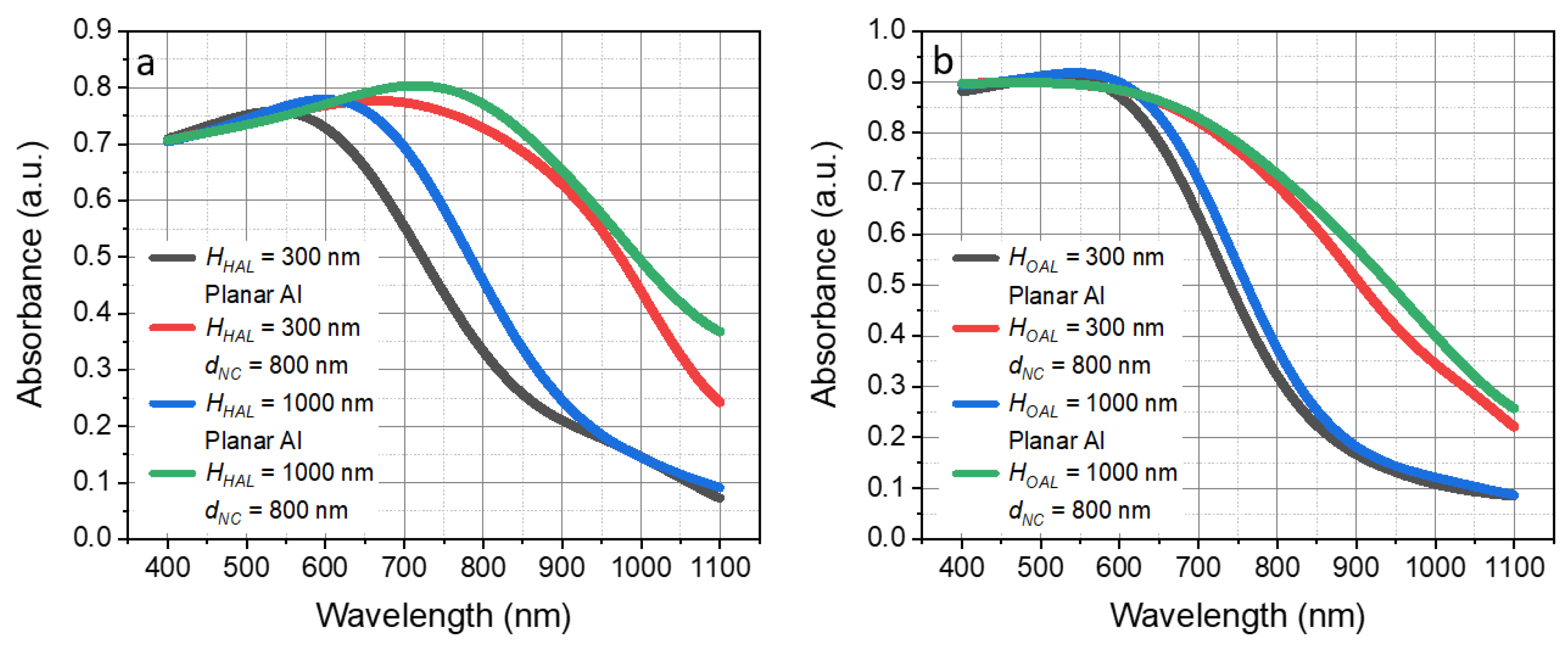
| 0.5 µm | 1.0 µm | 3.0 µm | 10 µm | |
|---|---|---|---|---|
| , % | 80.3 | 62.8 | 41.5 | 20.0 |
| 0.3 µm | 1.0 µm | |
|---|---|---|
| FAPbI3), % | 45.8 | 37.5 |
| PTB7:PC71BM), % | 34.1 | 32.3 |
Disclaimer/Publisher’s Note: The statements, opinions and data contained in all publications are solely those of the individual author(s) and contributor(s) and not of MDPI and/or the editor(s). MDPI and/or the editor(s) disclaim responsibility for any injury to people or property resulting from any ideas, methods, instructions or products referred to in the content. |
© 2023 by the authors. Licensee MDPI, Basel, Switzerland. This article is an open access article distributed under the terms and conditions of the Creative Commons Attribution (CC BY) license (https://creativecommons.org/licenses/by/4.0/).
Share and Cite
Marus, M.; Mukha, Y.; Wong, H.-T.; Chan, T.-L.; Smirnov, A.; Hubarevich, A.; Hu, H. Tsuchime-like Aluminum Film to Enhance Absorption in Ultra-Thin Photovoltaic Cells. Nanomaterials 2023, 13, 2650. https://doi.org/10.3390/nano13192650
Marus M, Mukha Y, Wong H-T, Chan T-L, Smirnov A, Hubarevich A, Hu H. Tsuchime-like Aluminum Film to Enhance Absorption in Ultra-Thin Photovoltaic Cells. Nanomaterials. 2023; 13(19):2650. https://doi.org/10.3390/nano13192650
Chicago/Turabian StyleMarus, Mikita, Yauhen Mukha, Him-Ting Wong, Tak-Lam Chan, Aliaksandr Smirnov, Aliaksandr Hubarevich, and Haibo Hu. 2023. "Tsuchime-like Aluminum Film to Enhance Absorption in Ultra-Thin Photovoltaic Cells" Nanomaterials 13, no. 19: 2650. https://doi.org/10.3390/nano13192650
APA StyleMarus, M., Mukha, Y., Wong, H.-T., Chan, T.-L., Smirnov, A., Hubarevich, A., & Hu, H. (2023). Tsuchime-like Aluminum Film to Enhance Absorption in Ultra-Thin Photovoltaic Cells. Nanomaterials, 13(19), 2650. https://doi.org/10.3390/nano13192650






